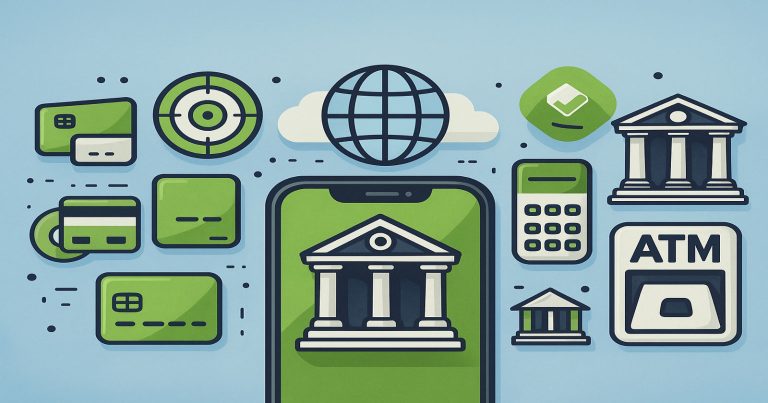Electronic banking, or e-banking, uses the internet and digital tools to offer banking services. People use mobile phones, computers, and ATMs to do banking without going to a bank. The features of e-banking help users manage their money easily, anytime, and anywhere. These features make banking faster, safer, and simpler. In India, e-banking is growing quickly. Many banks now offer complete online services. From checking balances to transferring money, e-banking makes life easier for all.
What is E-banking?
E-banking means using the internet or electronic devices to get banking services. It lets people do banking from home or work. Customers do not need to stand in long lines at the bank. They just use their phone or computer to handle their money.
Meaning of E-banking
Electronic banking is the digital way to manage bank accounts. Customers use the banks’ apps or websites. They can check their balance, transfer money, pay bills, and even apply for loans. This makes banking quick and smooth.
Use of E-banking in India
Many banks in India offer e-banking now. Banks like SBI, HDFC, ICICI, and Axis have apps and websites. These platforms are safe and easy to use. People in cities and villages use e-banking today. The e-banking features in India include mobile banking, UPI payments, NEFT, RTGS, and digital wallets.
Why People Use E-banking?
People use e-banking for many reasons:
- It saves time.
- It is available 24/7.
- It is safe and secure.
- It offers many services in one place.
E-banking helps banks, too. It cuts costs and reduces the load on staff. It also helps in reaching people in remote areas.
Types of Electronic Banking
E-banking has many types. These types provide different services to customers. Every type has its use and benefit. Banks in India offer all these types today.
Mobile Banking
Mobile banking uses a phone. Users download the bank’s app. They log in and use it to check their balance, pay bills, or transfer funds. This type is prevalent in India. Almost every bank has a mobile app today.
Internet Banking
Internet banking uses a browser and a bank’s website. People log in with a user ID and password. They can view account details, pay taxes, recharge phones, and open fixed deposits. This is a significant part of the features of online e-banking.
ATM Banking
ATM banking lets users withdraw cash and check their balance from machines. Many ATMs now allow mini-statements, fund transfers, and PIN changes. ATMs are found in almost every area in India.
Telebanking
Telebanking uses the phone for banking. A customer calls the bank and uses keypad instructions or talks to staff. This is useful when the internet is not available.
Point of Sale (POS)
POS systems are machines in shops. When people pay using cards, the bank account gets updated. This is part of the transactional features of e banking. POS helps in making shopping easy and cash-free.
Unified Payments Interface (UPI)
UPI is used to send money using mobile numbers or UPI IDs. Apps like PhonePe, Google Pay, and Paytm use UPI. It is fast, safe, and works 24/7. UPI has changed how people pay and is a key feature of e-banking services in India.
What are the Features of E-banking?
E-banking has many features and benefits. These help both customers and banks. Digital banking saves time, reduces effort, and gives complete control to customers.
24/7 Access
Users can do banking anytime. They do not need to wait for bank hours. This helps work people and students.
Easy Fund Transfers
E-banking allows quick money transfers. People use NEFT, RTGS, IMPS, and UPI to send money. These services are safe and fast. One can send money across India in seconds.
Online Bill Payments
Customers pay electricity, gas, mobile, and DTH bills online. This is one of the main features of e banking. It reduces the need to stand in lines.
Secure Transactions
Banks use OTP, PIN, passwords, and encryption. These methods protect user data. Cyber fraud is low when users follow safety rules.
Account Management
People can check their balance, get mini statements, and see transaction history. They can open or close FDs and RDs. They can update their address and contact details without going to the bank.
Cost-Effective Banking
E-banking saves money. Customers do not need to travel to banks. Banks also save money on staff and paperwork.
Green Banking
E-banking reduces the use of paper. This supports the environment. It cuts the carbon footprint and saves trees.
User-Friendly Services
Bank apps and websites are simple to use. Even people with little tech knowledge can use them. Banks offer help and guidance, too.
Online E-Banking Services
Online banking services help users get complete control of their accounts. These services cover everything from basic to advanced banking needs. People enjoy comfort and speed with these services.
Fund Transfer Services
These methods let users transfer money quickly and safely. These are essential features of online e-banking in India. This includes:
- NEFT (National Electronic Funds Transfer)
- RTGS (Real Time Gross Settlement)
- IMPS (Immediate Payment Service)
- UPI (Unified Payments Interface)
Loan Applications
People apply for personal loans, car loans, and home loans online. Banks show interest rates and EMI plans and approve loans faster.
Insurance and Investment
Users buy insurance plans and invest in mutual funds online. They track their performance too. These services help in growing savings.
Card Services
Online banking helps people apply for debit and credit cards. Users can block lost cards, set limits, and view statements online.
Tax and Utility Payments
Users pay taxes like GST and income tax. Using the bank’s app, they also pay electricity, water, gas, and broadband bills.
ePassbook and Statements
Banks offer digital passbooks. Users download account statements anytime. This helps in tracking spending and saving better.
Service Requests
Customers can:
- Order cheque books
- Stop cheques
- Update KYC
- Link Aadhaar
These are part of the features of e banking services that offer complete control to the customer.
Features of E Banking FAQS
1. What are the features of e banking in India?
The e-banking features in India include mobile banking, UPI, NEFT, RTGS, online bill payments, and secure transactions. Indian banks offer 24/7 access, account tracking, and digital service requests.
2. What are the features of online e-banking?
Features of online e-banking include checking balance, fund transfer, paying bills, applying for loans, downloading statements, and more. It offers complete access to banking from any device with internet.
3. What are the transactional features of e banking?
Transactional e-banking features include money transfers (NEFT, RTGS, IMPS, UPI), utility bill payments, card management, and buying insurance. These help customers complete all banking actions online.
4. Are e-banking services safe?
Yes, e-banking services are safe. Banks use OTP, passwords, PINs, and strong encryption. Users must not share login details and avoid unknown links.
5. How do features of e banking help students?
Students use e-banking to pay college fees, transfer money, recharge phones, and manage expenses. It saves time and gives them complete control of their money anytime.


